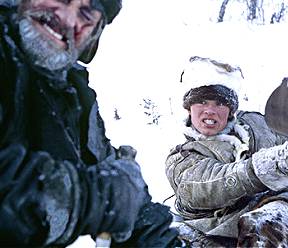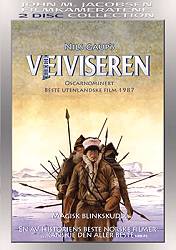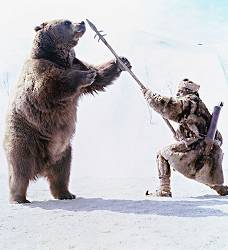|
|
| Sei in: Cinema e Medioevo ® Indice alfabetico dei film |
L'ARCIERE DI GHIACCIO
(Ofelas / Veiviseren)
1987, regia di Nils Gaup

Scheda: Nazione: Norvegia - Produzione: Filmkameratene A/S, Mayco, Norsk Film, Norway Film Development, The Norway Film Development Company - Distribuzione: Vivivideo, Cecchi Gori Home Video, Columbia Tristar, Norsk Filminstitutt Oslo, Carolco Pictures, LK-TEL - Soggetto: Nils Gaup - Sceneggiatura: Nils Gaup - Fotografia: Erling Thurmann-Andersen - Montaggio: Niels Pagh - Scenografia: Arald Egede Nissen Andersen - Costumi: Ida Gearon - Musiche: Nils-Aslak Valkeapaa, Marius Muller, Kjetil Bjerkestrand - Formato: Scope Color, linguaggio Saami - Durata: 87'.
Cast: Mikkel Gaup, Ingvald Guttorm, Nils Utsi, Henrik H. Buljo, Nils-Aslak Valkeapää, Inger Utsi, Helgi Skúlason, Svein Scharffenberg, Knut Walle, John Sigurd Kristensen, Sara Marit Gaup, Sverre Porsanger, Anne-Marja Blind, Ellen Anne Buljo, Svein Birger Olsen.



![]() Trama e commenti:
genovafilmfestival.it -
cinematografo.it:
«Una gelida sera degli anni intorno al mille,
Aigin, un fiero lappone sedicenne, sta rientrando dalla caccia sui rudimentali
sci, atteso dalla famiglia, quando da un'altura avvista una numerosa masnada di
Tsjudie feroci predatori dei villaggi lapponi. Appiattato dietro un cespuglio,
il ragazzo assiste inorridito allo scempio dei cadaveri dei familiari, trucidati
e gettati dagli Tsjude nel lago gelato, attraverso una crepa di ghiaccio che lo
ricopre. Tradito da uno degli sci, che gli è sfuggito dal piede scivolando giù
fra gli Tsjude, Aigin viene scoperto e inseguito dai predoni che lo colpiscono
con uno dei loro micidiali strali. Proprio grazie all'unico sci rimastogli, il
ragazzo riesce a sfuggire agli inseguitori e a riparare nel più vicino
villaggio, gettando il panico fra gli abitanti che lo accusano di aver segnato
la traccia ai predoni con la propria fuga, mettendo tutti in pericolo.Viene
perciò dato l'ordine di evacuare, mentre Aigin è amorevolmente curato dalla
giovane Paiblin, che si innamora di lui. L'indomani, allestite le slitte, tutti
se ne vanno lasciando solo Aigin che rifiuta di seguirli, deciso a far giustizia
degli Tsjude. Nella notte viene turbato da segni premonitori e raggiunto prima
dal "saggio" Raste, capo spirituale del villaggio che tenta di dissuaderlo
dall'impresa scomparendo poi misteriosamente, e successivamente da tre lapponi
del villaggio evacuato. Questi gli offrono aiuto, ma vengono quasi subito
massacrati dai Tsjude, sopraggiunti velocemente, proprio sotto gli occhi di
Aigin, che nascosto in un rifugio nella neve è impossibilitato a intervenire.
Ecco però riapparire di soppiatto Raste, che sollecita il ragazzo a mettersi in
salvo mentre lui cercherà di distrarre i predoni. Quando Aigin vede che Raste è
torturato dagli Tsjude, che vogliono sapere da lui il luogo dove è riparata la
tribù, balza fuori dal nascondiglio e si offre di guidarli lui stesso dai
rifugiati in cambio della vita di Raste».
Trama e commenti:
genovafilmfestival.it -
cinematografo.it:
«Una gelida sera degli anni intorno al mille,
Aigin, un fiero lappone sedicenne, sta rientrando dalla caccia sui rudimentali
sci, atteso dalla famiglia, quando da un'altura avvista una numerosa masnada di
Tsjudie feroci predatori dei villaggi lapponi. Appiattato dietro un cespuglio,
il ragazzo assiste inorridito allo scempio dei cadaveri dei familiari, trucidati
e gettati dagli Tsjude nel lago gelato, attraverso una crepa di ghiaccio che lo
ricopre. Tradito da uno degli sci, che gli è sfuggito dal piede scivolando giù
fra gli Tsjude, Aigin viene scoperto e inseguito dai predoni che lo colpiscono
con uno dei loro micidiali strali. Proprio grazie all'unico sci rimastogli, il
ragazzo riesce a sfuggire agli inseguitori e a riparare nel più vicino
villaggio, gettando il panico fra gli abitanti che lo accusano di aver segnato
la traccia ai predoni con la propria fuga, mettendo tutti in pericolo.Viene
perciò dato l'ordine di evacuare, mentre Aigin è amorevolmente curato dalla
giovane Paiblin, che si innamora di lui. L'indomani, allestite le slitte, tutti
se ne vanno lasciando solo Aigin che rifiuta di seguirli, deciso a far giustizia
degli Tsjude. Nella notte viene turbato da segni premonitori e raggiunto prima
dal "saggio" Raste, capo spirituale del villaggio che tenta di dissuaderlo
dall'impresa scomparendo poi misteriosamente, e successivamente da tre lapponi
del villaggio evacuato. Questi gli offrono aiuto, ma vengono quasi subito
massacrati dai Tsjude, sopraggiunti velocemente, proprio sotto gli occhi di
Aigin, che nascosto in un rifugio nella neve è impossibilitato a intervenire.
Ecco però riapparire di soppiatto Raste, che sollecita il ragazzo a mettersi in
salvo mentre lui cercherà di distrarre i predoni. Quando Aigin vede che Raste è
torturato dagli Tsjude, che vogliono sapere da lui il luogo dove è riparata la
tribù, balza fuori dal nascondiglio e si offre di guidarli lui stesso dai
rifugiati in cambio della vita di Raste».
![]() Plot Summary, Synopsis, Review:
IMDb -
entertainment.msn.com -
tvguide.com:
« «...In the
10th century, on the frozen plains of Lapland, in the northernmost part of
Norway, a peaceful tribe of families is menaced by nomadic savages called the
Tchude. Sixteen-year-old Aigin (Mikkel Gaup) returns from a solo hunting trip to
witness his parents and little sister being murdered by this savage band. He is
wounded by a Tchude crossbow, but manages to escape on a single ski to a
neighboring tribe. He warns this tribe of the oncoming savagery of the Tchude,
and the camp is split between those who want to stay and fight and others who
choose to flee to a safer haven on the northern coast. Aigin stays back at the
campsite with the braver element and is captured by the Tchude, who slaughter
all of the other remaining men. The Tchude then force Aigin to lead them to
those who fled. When all seems most hopeless, however, Aigin concocts an
eleventh-hour scheme that places him in deadly peril but that eventually saves
the day. Pathfinder is based on an ancient
Lapp legend and is the first film to be shot in the Lapp language. It is also
the first Scandinavian film to be made in wide-screen 70-millimeter Panavision
and recorded in Dolby six-track stereo, and these two technical processes give
vital dimension to the tale. Indeed, if there is any one true star of the piece,
it is Erling Thurmann-Andersen's awe-inspiring cinematography, which captures
the icy, bleak terrain of the Arctic with sublime power. The plot unfolds slowly,
but gathers force as it reaches its exhilarating, death-defying climax. It
behooves the viewer to set aside all expectations of immediate slam-bang
gratification and merely revel in the invigorating, unfamiliar locale--the world
of Scandinavian folklore. Animals figure prominently in this milieu, adding
their own aura of mythic depth. The acting is as artless as is required. Mikkel
Gaup, besides being a whiz on skis, is angelic and determined; Nils Utsi as
Raste, Aigin's spiritual leader, is saturnine and self-sacrificing; and the
Tchude themselves ooze evil, with Svein Scharffenberg a terrifying standout as
their leader. It should be noted that the Lapp tribeswomen are presented as
intelligent, strong presences, every bit the survivalist equals of their men».
Plot Summary, Synopsis, Review:
IMDb -
entertainment.msn.com -
tvguide.com:
« «...In the
10th century, on the frozen plains of Lapland, in the northernmost part of
Norway, a peaceful tribe of families is menaced by nomadic savages called the
Tchude. Sixteen-year-old Aigin (Mikkel Gaup) returns from a solo hunting trip to
witness his parents and little sister being murdered by this savage band. He is
wounded by a Tchude crossbow, but manages to escape on a single ski to a
neighboring tribe. He warns this tribe of the oncoming savagery of the Tchude,
and the camp is split between those who want to stay and fight and others who
choose to flee to a safer haven on the northern coast. Aigin stays back at the
campsite with the braver element and is captured by the Tchude, who slaughter
all of the other remaining men. The Tchude then force Aigin to lead them to
those who fled. When all seems most hopeless, however, Aigin concocts an
eleventh-hour scheme that places him in deadly peril but that eventually saves
the day. Pathfinder is based on an ancient
Lapp legend and is the first film to be shot in the Lapp language. It is also
the first Scandinavian film to be made in wide-screen 70-millimeter Panavision
and recorded in Dolby six-track stereo, and these two technical processes give
vital dimension to the tale. Indeed, if there is any one true star of the piece,
it is Erling Thurmann-Andersen's awe-inspiring cinematography, which captures
the icy, bleak terrain of the Arctic with sublime power. The plot unfolds slowly,
but gathers force as it reaches its exhilarating, death-defying climax. It
behooves the viewer to set aside all expectations of immediate slam-bang
gratification and merely revel in the invigorating, unfamiliar locale--the world
of Scandinavian folklore. Animals figure prominently in this milieu, adding
their own aura of mythic depth. The acting is as artless as is required. Mikkel
Gaup, besides being a whiz on skis, is angelic and determined; Nils Utsi as
Raste, Aigin's spiritual leader, is saturnine and self-sacrificing; and the
Tchude themselves ooze evil, with Svein Scharffenberg a terrifying standout as
their leader. It should be noted that the Lapp tribeswomen are presented as
intelligent, strong presences, every bit the survivalist equals of their men».
Conosciuto anche con il titolo: Pathfinder.